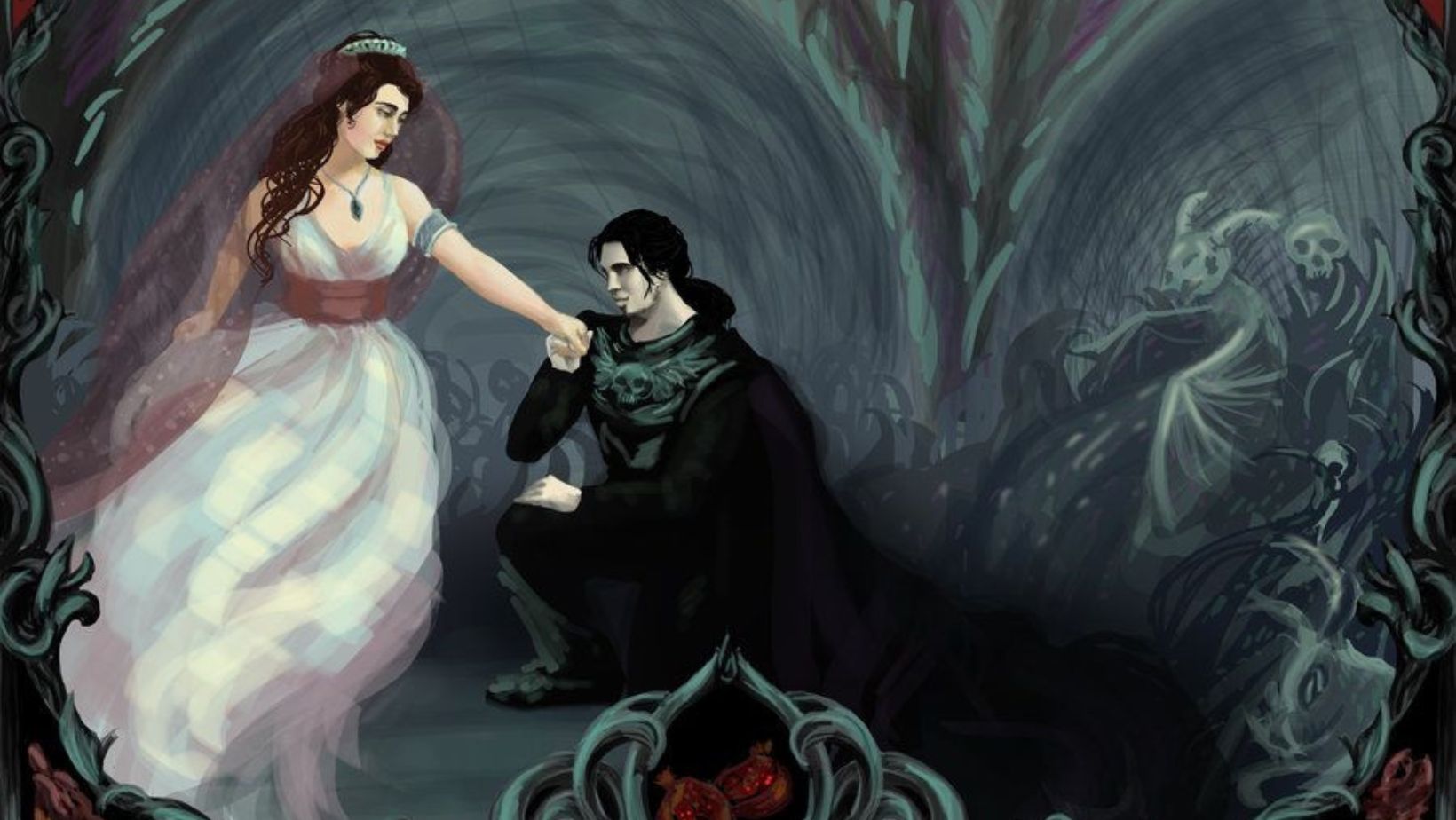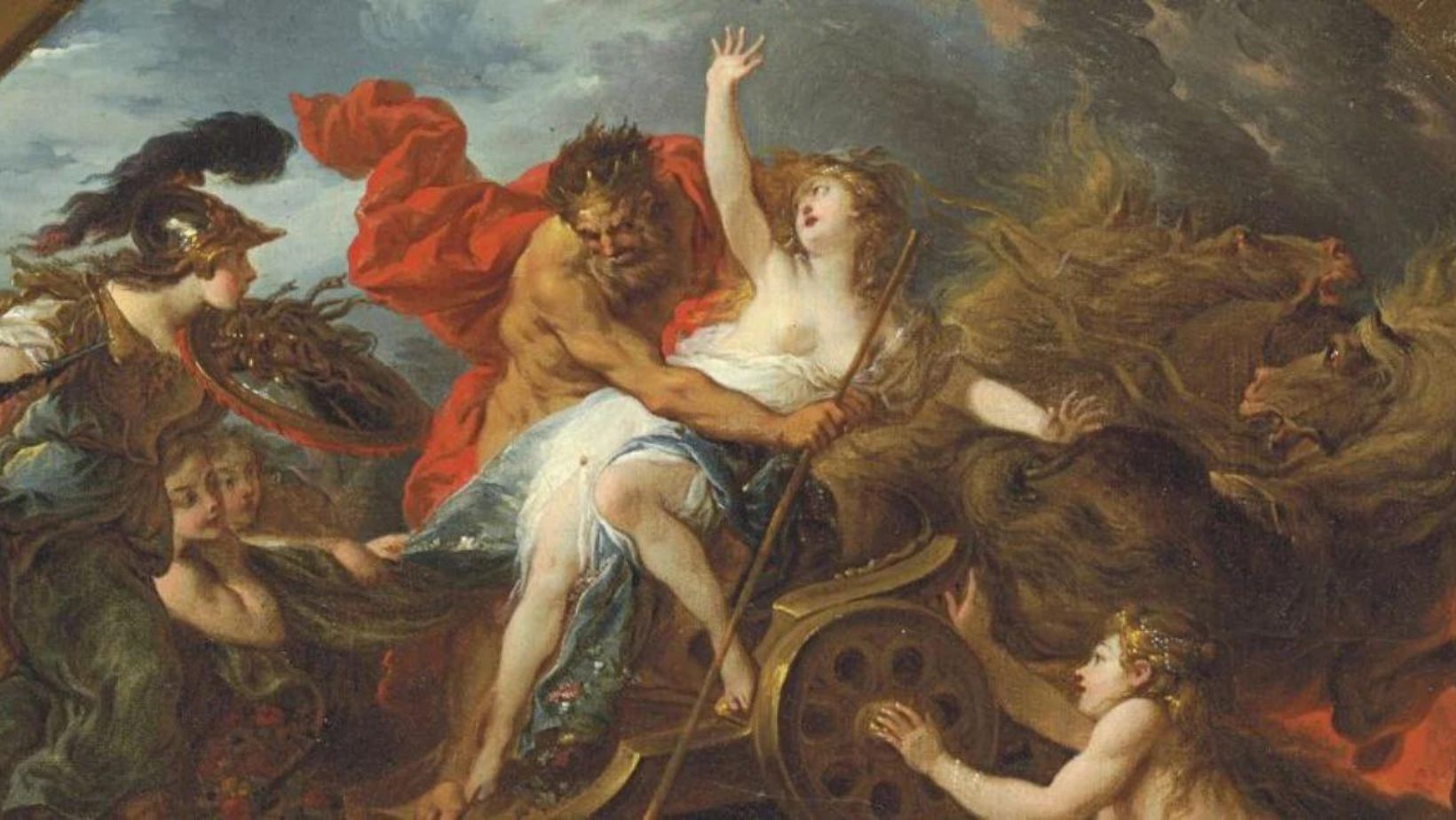Persephone Queen of the Underworld, is an alluring and enigmatic figure. Her story is one of love, loss, and the cycle of life and death, and it has captured the hearts and minds of people for centuries.
But who was Persephone, really? And why has her myth endured for so long? I want to take you on a journey through the twists and turns of her incredible story. Along the way, we’ll discover the deeper meanings and symbolism that make her such a fascinating and enduring figure.
So, are you ready to step into the realm of Persephone, Queen of the Underworld? Let’s go!
Table of Contents:
- The Myth of Persephone, Queen of the Underworld
- Persephone’s Abduction and the Origin of the Seasons
- Persephone’s Dual Role as Queen of the Underworld and Goddess of Spring
- The Symbolism and Significance of Persephone in Greek Mythology
- Conclusion
The Myth of Persephone, Queen of the Underworld

One of the most well-known Greek myths is the story of Persephone, queen of the underworld. It’s a tale that’s been passed down for generations, captivating audiences with its themes of love, loss, and the cycle of life and death.
As someone who’s spent years studying Greek mythology, I’ve always been fascinated by Persephone’s journey. Her story is a powerful one that resonates with us deeply, even today.
Persephone’s Role in Greek Mythology: Persephone Queen of the Underworld
In Greek religion, Persephone was a central figure. She was the goddess of spring growth and the queen of the underworld. This dual role made her a key player in the pantheon of Greek gods.
As the daughter of Demeter, the goddess of agriculture, Persephone was closely tied to the earth and the cycle of the seasons. Her story helped the ancient Greeks make sense of the world around them.
Persephone’s Family Tree: Persephone Queen of the Underworld
Persephone’s family tree reads like a who’s who of Greek mythology. Her father was none other than Zeus, king of the gods. Her mother, Demeter, was one of the most important goddesses in the pantheon.
This divine lineage meant that Persephone was born into power and privilege. But it also meant that she was caught up in the complex web of relationships and rivalries that characterized the Greek gods.
The Abduction of Persephone: Persephone Queen of the Underworld
The most famous myth involving Persephone is the story of her abduction by Hades, god of the underworld. According to the tale, Hades fell in love with Persephone and decided to kidnap her while she was picking flowers in a meadow.
This event set in motion a chain of events that would change the world forever. Demeter, distraught at the loss of her daughter, searched the earth for her. As a result, crops failed and famine spread across the land.
Persephone’s Abduction and the Origin of the Seasons: Persephone Queen of the Underworld
The abduction of Persephone by Hades is more than just a dramatic tale. It’s a story that helped the ancient Greeks explain the changing of the seasons and the cycle of life and death.
When Persephone was taken to the underworld, her mother Demeter fell into a deep depression. She neglected her duties as the goddess of agriculture, causing crops to wither and die. This, according to the myth, is why we have winter – a time when the earth lies barren and cold.
Hades’ Plan to Kidnap Persephone

Hades, the god of the underworld, was a fearsome figure in Greek mythology. He ruled over the dead and was rarely seen in the world above. But when he laid eyes on Persephone, he fell deeply in love.
Determined to make her his queen, Hades devised a plan to kidnap Persephone. He waited until she was alone, picking flowers in a meadow, and then burst forth from the earth in his chariot, snatching her away to the underworld.
Demeter’s Search for Her Daughter: Persephone Queen of the Underworld
Demeter was heartbroken when she noticed her daughter Persephone had vanished. Desperate, she scoured every part of earth looking for answers, all while obliviously letting the harvest fields wither.
As Demeter roamed the earth, crops began to wither and die. Famine spread across the land, and the gods grew concerned. They knew that if Demeter did not return to her duties, all of humanity would perish.
The Pomegranate Seeds and Persephone’s Fate
Eventually, Zeus intervened and commanded Hades to return Persephone. Hades agreed, but not before tricking Persephone into eating pomegranate seeds. In Greek mythology, consuming food in the underworld meant that one was bound to return.
Because Persephone had eaten six pomegranate seeds, it was decided that she would spend six months of each year in the underworld with Hades. The other six months, she would return to earth and be reunited with her mother.
This compromise became the basis for the Greek understanding of the seasons. When Persephone was in the underworld, Demeter would grieve, causing winter to fall upon the earth. But when Persephone returned each spring, Demeter’s joy would cause flowers to bloom and crops to grow once more.
Key Takeaway: Persephone Queen of the Underworld
Persephone’s tale explains the seasons. Her time in the underworld causes winter, while her return brings spring and growth.
Persephone’s Dual Role as Queen of the Underworld and Goddess of Spring
Persephone, queen of the underworld, is a complex and fascinating figure in Greek mythology. Her story is one of duality, as she embodies both the darkness of the underworld and the light of spring.
In this article, we’ll explore Persephone’s time in the underworld, her return to earth, and the delicate balance between life and death that she represents.
Persephone’s Time in the Underworld: Persephone Queen of the Underworld
As the wife of Hades, Persephone spent a significant portion of each year in the underworld. During this time, she ruled alongside her husband, overseeing the souls of the dead.
Despite the dark and gloomy nature of the underworld, Persephone’s presence brought a sense of light and life to the realm. Her youthful energy and beauty were a stark contrast to the somber atmosphere of Hades’ domain.
In the underworld, Persephone had the power to grant or deny the requests of the dead. She could offer them a place in the Elysian Fields, a paradise for the virtuous, or condemn them to eternal torment.
Persephone’s role as queen of the underworld was not an easy one. She had to navigate the complex politics of the gods and maintain order in a realm filled with restless souls. Yet, despite the challenges, she proved herself to be a capable and compassionate ruler.
Persephone’s Return to Earth

Each spring, Persephone would return to earth, bringing with her the warmth and new growth of the season. Her mother, Demeter, would rejoice at her daughter’s return, and the earth would burst forth with new life.
During her time on earth, Persephone was celebrated as the goddess of spring and vegetation. She was associated with the cyclical nature of life, as she embodied the renewal and rebirth that came with each new season.
Persephone’s return to earth was not just a symbol of the changing seasons, but also a reminder of the enduring bond between mother and daughter. Demeter’s love for her daughter was so strong that it had the power to bring life back to the world.
The Balance Between Life and Death: Persephone Queen of the Underworld
Persephone’s dual role as queen of the underworld and goddess of spring represents the delicate balance between life and death. Her story reminds us that death is a natural part of the cycle of existence, and that new life springs forth from the darkness.
In many ways, Persephone’s journey mirrors the human experience. We all face times of darkness and struggle, but we also have the capacity for growth and renewal. Just as Persephone emerged from the underworld each spring, we too can find the strength to overcome our challenges and embrace new beginnings.
Persephone’s story also highlights the importance of balance in our lives. Just as she split her time between the underworld and earth, we must learn to navigate the ups and downs of existence. We cannot have light without darkness, or joy without sorrow.
Ultimately, Persephone’s dual role reminds us of the interconnectedness of all things. Life and death, darkness and light, sorrow and joy – these are all part of the same eternal cycle. By embracing this truth, we can find meaning and purpose in even the most challenging of times.
The Symbolism and Significance of Persephone in Greek Mythology: Persephone Queen of the Underworld
Persephone, queen of the underworld, is a figure of great symbolic importance in Greek mythology. Her story is rich with meaning and significance, offering insights into the human experience and the natural world.
In this article, we’ll explore Persephone as a symbol of rebirth and renewal, her role in the Eleusinian Mysteries, and her relationships with other gods and goddesses.
Persephone as a Symbol of Rebirth and Renewal
One of the most powerful symbolic aspects of Persephone’s story is her role as a figure of rebirth and renewal. Each spring, when she returned to earth from the underworld, she brought with her the promise of new life and growth.
This symbolism was deeply meaningful to the ancient Greeks, who saw in Persephone’s journey a reflection of the natural world. Just as the earth lay dormant in the winter months, only to burst forth with new life in the spring, Persephone’s story represented the eternal cycle of death and rebirth.
For the Greeks, Persephone’s return to earth was a time of great celebration. Her arrival marked the beginning of the planting season, when farmers would sow their crops in anticipation of a bountiful harvest. In this way, Persephone was seen as a bringer of abundance and fertility.
But Persephone’s symbolism goes beyond the natural world. Her story also speaks to the human experience of growth and transformation. Just as Persephone emerged from the darkness of the underworld, we too have the capacity to overcome our struggles and embrace new beginnings.
The Eleusinian Mysteries and Persephone’s Role: Persephone Queen of the Underworld
Persephone played a central role in the Eleusinian Mysteries, a secret religious cult in ancient Greece that promised initiates a better afterlife. The mysteries were based on the myth of Persephone’s abduction and return, and participants would reenact her journey as part of the initiation rites.
The Eleusinian Mysteries were one of the most important religious institutions in ancient Greece, attracting initiates from all over the Greek world. The cult was shrouded in secrecy, and participants were sworn to keep the details of the rites confidential.
At the heart of the Eleusinian Mysteries was the idea of transformation and rebirth. Participants believed that by reenacting Persephone’s journey, they could achieve a kind of spiritual awakening and ensure a better afterlife.
Persephone’s role in the Eleusinian Mysteries highlights her importance as a figure of mystery and transformation. Her story inspired countless individuals to seek out the secrets of life and death, and to strive for a deeper understanding of the world around them.
Persephone’s Relationships with Other Gods and Goddesses
Throughout her story, Persephone interacts with a wide range of other gods and goddesses, each of whom plays a significant role in her journey. Her relationships with these deities reveal important aspects of her character and symbolism.
Perhaps the most important relationship in Persephone’s story is her bond with her mother, Demeter. Demeter’s love for her daughter is so strong that it has the power to bring life back to the world. In many ways, their relationship represents the unbreakable bond between mother and child.
Persephone’s marriage to Hades is another significant relationship in her story. Although their union begins with an abduction, over time Persephone grows into her role as queen of the underworld. Her relationship with Hades represents the idea that even in the darkest of places, there is the potential for growth and transformation.
Persephone also has important relationships with other gods and goddesses, such as Hecate, the goddess of magic and crossroads, and Hermes, the messenger god who helps to negotiate her return to earth. These relationships highlight Persephone’s importance within the larger pantheon of Greek deities.
Ultimately, Persephone’s relationships with other gods and goddesses underscore her significance as a figure of transformation and renewal. Through her interactions with these deities, we gain a deeper understanding of the complex web of meaning that underlies her story.
Key Takeaway: Persephone Queen of the Underworld
Persephone, queen of the underworld and goddess of spring, symbolizes the balance between life and death. Her dual role shows how new beginnings arise from darkness. Each year she brings renewal to earth, while ruling over souls in Hades’ realm. Her story highlights growth through struggle and transformation.
Conclusion: Persephone Queen of the Underworld
Persephone’s story is a testament to the power of love, the inevitability of change, and the cyclical nature of life itself. Her journey from innocent maiden to Queen of the Underworld is one that’s filled with drama, passion, and profound symbolism.
Through her myth, we see the changing of the seasons, the balance of light and dark, and the eternal dance of life and death. Persephone’s tale reminds us that even in the darkest of times, there’s always hope for renewal and rebirth.
So the next time you bite into a juicy pomegranate seed or marvel at the first blooms of spring, remember Persephone, the Queen of the Underworld, and the enduring legacy she’s left on our collective imagination.

